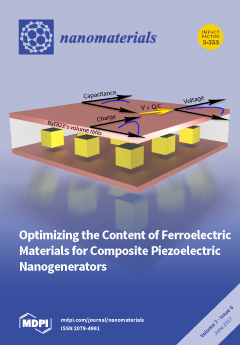Superparamagnetic Fe
3O
4 nanoparticles on hydroxyapatite nanorod based nanostructures (Fe
3O
4/HAp) were synthesized using hydrothermal techniques at 180 °C for 12 h and were used as drug delivery nanocarriers for cancer cell therapeutic applications. The synthesized Fe
3
[...] Read more.
Superparamagnetic Fe
3O
4 nanoparticles on hydroxyapatite nanorod based nanostructures (Fe
3O
4/HAp) were synthesized using hydrothermal techniques at 180 °C for 12 h and were used as drug delivery nanocarriers for cancer cell therapeutic applications. The synthesized Fe
3O
4/HAp nanocomposites were characterized by X-ray diffraction analysis (XRD), Field emission scanning electron microscopy (FESEM), Fourier transform infrared spectroscopy (FTIR), Brunauer-Emmett-Teller (BET)-analysis, and vibrating sample magnetometry (VSM). The morphologies of the Fe
3O
4/HAp nanocomposites show 15 nm Fe
3O
4 nanoparticles dispersed in the form of rods. The BET result shows that the synthesized samples have a high specific surface area of 80 m
2 g
−1 with mesoporous structures. Magnetic measurements revealed that the sample has high saturation magnetization of 18 emu/g with low coercivity. The Fe
3O
4/HAp nanocomposites had a large specific surface area (SSA), high mesoporous volume, and good magnetic property, which made it a suitable nanocarrier for targeted drug delivery systems. The chemotherapeutic agent, andrographolide, was used to investigate the drug delivery behavior of the Fe
3O
4/HAp nanocomposites. The human epidermoid skin cancer cells (A431) were used as the model targeting cell lines by treating with andrographolide loaded Fe
3O
4/HAp nanosystems and were further evaluated for their antiproliferative activities and the induction of apoptosis. Also, the present nanocomposite shows better biocompatibility, therefore it can be used as suitable drug vehicle for cancer therapy applications.
Full article






